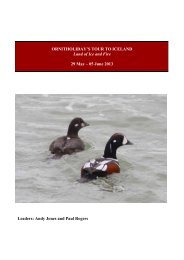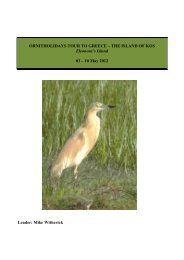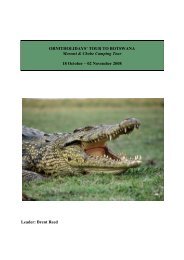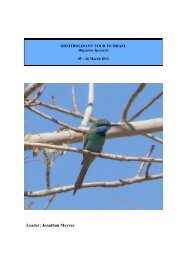Download 2014 Brochure (.pdf) - Ornitholidays
Download 2014 Brochure (.pdf) - Ornitholidays
Download 2014 Brochure (.pdf) - Ornitholidays
You also want an ePaper? Increase the reach of your titles
YUMPU automatically turns print PDFs into web optimized ePapers that Google loves.
Petra<br />
Sand Partridge<br />
J O R D A N<br />
Outline itinerary<br />
Day 1 Fly to Amman<br />
Day 2 Amman<br />
Days 3-4 Azraq<br />
Day 5 Dead Sea<br />
Days 6-7 Petra<br />
Days 8-9 Aqaba<br />
Day 10 Depart Amman<br />
Party Size<br />
Maximum of 12 clients (two leaders with<br />
more than six clients).<br />
Accommodation<br />
Comfortable accommodation in twin-bedded<br />
and single rooms, with private facilities.<br />
Transport<br />
By small coach or minibus.<br />
Basalt Desert at Safawi, where we look for the<br />
dark morph of Mourning Wheatear (known as<br />
Basalt Wheatear), Thick-billed and Bar-tailed<br />
Desert Larks and Trumpeter Finch. We shall also<br />
visit Azraq Castle, which has been involved in<br />
wars since the Roman times.<br />
Day 5<br />
In the morning we will leave Azraq and head<br />
west, towards the Dead Sea. On the way we shall<br />
visit Mount Nebo, Wadi Midjub and the shores of<br />
the Dead Sea. Highlights today may include<br />
Dead Sea Sparrow, Palestine Sunbird, Whitespectacled<br />
Bulbul, Little Green Bee-eater,<br />
Mourning Wheatear, Arabian Warbler, Arabian<br />
Babbler, Sand Partridge, Greater Hoopoe and<br />
Dunn’s Larks and Blackstart. We stay overnight<br />
at a hotel near to the Dead Sea.<br />
Days 6 & 7<br />
Today we drive further south and we will explore<br />
the Wadi Dana reserve. Here we can expect to<br />
find Tristram’s Starling, Syrian Serin, Chukar,<br />
Rock Martin, Scrub Warbler and raptors<br />
including Bonelli’s Eagle, Barbary Falcon and<br />
Eurasian Griffon Vulture.<br />
Later we make the short drive to Petra where we<br />
stay for two nights. Petra is one of the wonders of<br />
the Middle Eastern World, a gigantic natural<br />
amphitheatre, hidden in the rocks, out of which a<br />
delicately coloured city, with immense façades,<br />
has been carved. The temples and caves of<br />
Petra rest high up above a chasm, with huge<br />
white rocks forming the Bab, or gate, of the Siq,<br />
the narrow entrance towering more than 20<br />
metres high. Bird life here in the desert is scarce,<br />
but we would hope to see Barbary Falcon,<br />
Blackstart, Palestine Sunbird, Sinai Rosefinch,<br />
Striolated Bunting, White-crowned Wheatear and<br />
Fan-tailed Raven. In the evening we will look for<br />
the elusive Hume’s Owl.<br />
Days 8 & 9<br />
This morning we leave Petra and drive to Wadi Rum.<br />
In this gorge we have our best chance of seeing the<br />
very scarce Verreaux's Eagle. Other species of note<br />
here include Hooded Wheatear, Brown-necked<br />
Raven, Trumpeter Finch, Blackstart, Long-legged<br />
Buzzard, Rock Martin, Masked Shrike and Tristram's<br />
Starling. We then move on to the Red Sea and our<br />
final destination, Aqaba, where we stay for two<br />
nights. This coastal resort overlooks the Israeli town<br />
of Eilat – whereas Eilat has managed to degrade<br />
much of the good birding habitat, Aqaba has kept<br />
much of its cover, influencing the migrating birds to<br />
move from Israel to Jordan!<br />
In the Gulf we may see Brown Booby, Western<br />
Reef Heron and perhaps a lingering Great Blackheaded<br />
Gull. The shore often holds Indian<br />
House Crows, Greater Sand Plover and Whiteeyed<br />
Gull. The Gulf is a great flyway for migrating<br />
birds, and if conditions are right, we may find<br />
many grounded migrants in Aqaba. No<br />
<strong>Ornitholidays</strong>’ tour is complete without a sewage<br />
works visit, and Aqaba can provide this! The<br />
area is thronged with waterbirds and migrants<br />
and we can look for Little Green Bee-eater,<br />
Eurasian Hoopoe, Eurasian Wryneck, Collared<br />
and Semi-collared Flycatchers, Red-throated<br />
Pipit, Black-headed Wagtail, Common Quail, and<br />
many species of lark, swallow and pipit.<br />
The drier habitats hold Striolated Bunting, Sand<br />
Partridge, White-crowned and Hooded Wheatears<br />
and overhead we can always be on the lookout<br />
for migrating flocks of herons, storks or waders,<br />
or the numerous birds of prey such as Black Kite,<br />
Lesser Spotted Eagle and Steppe Buzzards.<br />
Day 10<br />
We drive to Amman, with a few stops for birding<br />
en route. Later, we catch our flight home and<br />
arrive into London in the early evening.<br />
Includes<br />
All flights, meals, accommodation, transport,<br />
entry fees, services of the leaders, airport<br />
taxes and tips.<br />
Gradings<br />
Good<br />
150<br />
Blackstart<br />
Mainly Warm<br />
Low<br />
Special<br />
Relaxed<br />
Excellent<br />
Easy<br />
Scheduled<br />
To make a booking please call <strong>Ornitholidays</strong> on 01794 519445<br />
69








